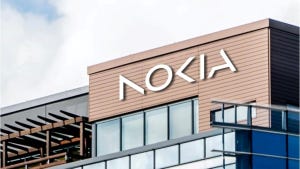Brightlink: My Switch Is Bigger Than Yours
Startup beats the 1,000 port barrier, with an electrical core
March 24, 2000

A debate over who's making the biggest optical switch will take a new turn next Monday (March 27) when Brightlink Networks, Inc. -- until now called Corvia Networks http://www.corvia.com -- plans to unveil its new name and release some preliminary information about its developments.
The startup is developing an optical switch with an electrical core. Its claim to fame is that its switch is much more scalable than the ones from other vendors already in this market - notably Sycamore Networks http://www.sycamorenet.com, Ciena Corp. http://www.ciena.com (via its acquisition of Lightera), Cisco Systems Inc. http://www.cisco.com (via its acquisition of Monterey) and Tellium Inc. http://ww.tellium.com.
Brightlink says its switch can link together a lot more wavelengths than its competitors. The initial version of its equipment, which is scheduled to ship in the fourth quarter of this year, can be configured with as many as 1,024 OC-48 (2.5 Gbit/s) ports. Future upgrades will push this maximum port count to 4,000, 16,000 and eventually 64,000, according to Gary Law, vice president of marketing.
The key point here is that Brightlink plans to do this while retaining an electrical core. All vendors say they can scale to huge numbers of ports. "We wouldn't get in the door with carriers if we couldn't do that," notes Nicholas De Vito, Tellium's vice president of product management and business development. But other vendors are banking on being able to shift over to using optical cores to deliver switches with more than 256 or 512 ports.
So why should carriers go with Brightlink and its electrical core, rather than, say, an upgraded Tellium with an optical core, if they need a 1,000 port switch?
One answer is that it's simply a matter of timing. All-optical switching technologies are still at an early stage of development and probably won't be ready for operational use for another 12-18 months. So Brightlink may have a window of opportunity to sell its switch while other vendors are shifting to optical cores.
Another answer is that carriers will need electrical cores to control their networks. Right now, signaling for optical networking is in its infancy.
A further advantage of using an electrical core is that it adds another dimension to Brightlink's scalability. Its switch can handle a whole range of bandwidths, down to STS-1 (51.5 Mbit/s). All optical cores switch whole wavelengths - in other words, very big pipes. In fact, even existing switches with electrical cores can't deliver the granularity of Brightlink, Law claims.
Brightlink's scalability and granularity comes from using a different type of switching fabric from other vendors. Its "hypertorus mesh switch architecture" ropes together a lot of relatively small, 18-port switches, using a mesh topology. Incoming traffic is chopped up into cells and routed over this miniature mesh, in much the same way as packets are routed over the Internet. A special algorithm makes sure that traffic takes no more than 13 microseconds to traverse the entire switch, according to Law, well within the 125 microsecond delay needed to carry streams of Sonet traffic.
Other switches in this market segment use so called "three-stage Clos" switching fabrics. They work on a similar basis to circuit-switched telephone networks, setting up and tearing down connections between input and output ports, albeit in miniature and at very fast speeds.
The problem here is that this switch has to be on one big piece of silicon, and right now, making anything more than a 256 or 512 port Clos switch is "pushing the limits of chip technology," according to Law.
In contrast, Brightlink's design is made up of lots of relatively small, 18-port switches that are a breeze to make, according to Law. They use 0.25 micron technology, not state-of-the-art 0.18 micron technology, and the switches can be implemented using less than one million gates and 600 pins.
Not everybody is convinced by Brightlink's arguments. "There's some debate about the viability of BrightLink's architecture," notes Scott Clavenna, principal analyst at Pioneer Consulting LLC http://www.pioneerconsulting.com. Brightlink has dodged the problem of having to build a big Clos switch in silicon, but the jury's still out on how many smaller switches can be combined in its architecture. The links between the switches may become a bottleneck.
It's worth noting that Brightlink wasn't even planning to build a switch in its original incarnation.
In the beginning, Phil Hughes and Bob Lipp, two experts from the semi-conductor industry set up a company called "Uniant" to develop switching fabric for sale to OEMs. Then they discovered that it was going to be easier to raise money if they came up with a complete switch, so they changed tune and renamed their company Corvia.
That wasn't the end of the matter. Corvis Corp. http://www.corvis.com, which is developing an all-optical switch, threatened to sue Corvia, saying folk were confusing the two companies. So Corvia backed down and ended up buying its latest name, Brightlink, for an undisclosed sum.
by Peter Heywood, international editor, Light Reading http://www.lightreading.com
Feedback from a reader who wants to remain anoymous:
Hi, I’m a heavy reader of lightreading.com. Being a researcher and architect of optical networks, I’m often disappointed by non-technical publications on the field, which tend to be overly hyped, shallow and mislead by vendor marketing efforts. This is not the case with lightreading, which is always critical and deep.
One area in which confusion exists is optical crossconnects, and in particular – in your article about Brightlink. A few inaccuracies I found are:
1. ELECTRICAL CORE ALLOWS MORE MANAGEABILITY THAN AN OPTICAL CORE: this is only true if the electrical core works at a lower granularity (e.g., STS-1) instead of the wavelength granularity – e.g., in the Ciena crossconnect. If one uses a high speed (OC-48), low port count (1000’s port) system to switch entire wavelengths (such as what most companies intend to do, including Tellium, I believe), then the functionality of the system is exactly the same irrespective of the technology for the core. What really impacts the functionality of such a system is whether the core is surrounded by all-optical ports or electro-optical ports, since the latter can peek into the bit stream (for instance, to measure the bit error rate) and change bits (for signaling purposes, mainly). This is what sets, say, a Xros system apart from a Tellium system even if the latter uses an optical core. The upside for an all-optical port is a much lower cost and support for any bit rate, while an electro-optical port is bit rate specific.
2. SIGNALING FOR OPTICAL CROSSCONNECTS IS IN ITS INFANCY: True. But so is signaling for electrical crossconnects for the optical layer. The standard bodies (ANSI, IETF, OIF, ODSI) are only now coming out with embryonic versions of standards for such systems.
3. A CLOS ARCHITECUTE IS LESS SCALABLE AND IS BASED ON A SINGLE CHIP: this is really quite far from reality. The whole idea about Clos is exactly how to “rope together” smaller switches into a large switch. I don’t know what Brightlink refers to as their “hypertorous mesh”, but it sure seems to be based on a very similar principle. The switch chips that other vendors use for their Clos architectures are also small (32x32, 64x64) OC-48 switches by at least 3 chip vendors. There are many known alternatives to Clos which have different characteristics, but they all share one problem: creating a large switch out of lots of smaller switches involves a zoo of cables which are very hard to manage and to scale, and by the time the signal goes through them it is much degraded and requires costly regeneration. Note that these statements are true for both electrical core technology and optical core technology. This is why optical core proponents are trying to shoot for a “single stage” core, which does not require roping small components together.
You May Also Like










